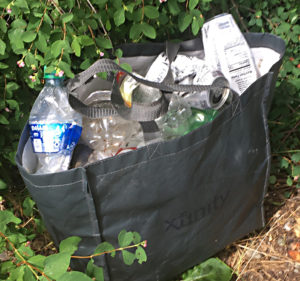
Sally Brown
Shoelaces used to be the excuse. Sarah, our daughter, would get dragged out to go for a run with her dad. She would go, but would routinely stop to tie her shoelaces, a surefire way to get a break during a run. Her shoelaces would miraculously untie at least once a mile.
You may have first-hand experience with untied shoelaces during a run. Now there is a new, fabulous excuse to take breaks during runs. It also works for jogs and walks. Instead of running you can go plogging. The word doesn’t stand for anything you’d recognize as this activity started in Sweden. If you are Swedish you may recognize that plogging is short for running and picking up litter.
I highly recommend the activity. Bring a bag with you and stop to pick up trash. Stop and pick up one piece or many pieces. Unfortunately, street litter gives you many more opportunities to stop than shoelaces. But here is the thing — picking up just one piece of trash per run or walk is a good deal. There is no way to go but up with plogging.
I myself hate running. If I have to work out on land, walking is my preferred activity. I walk a lot near our house in the mountains with really spectacular scenery. Scenery that is marred by the occasional beer can or plastic bag. I realized that there was no park service. And before I had heard of plogging I went with a few bags for my walk. That first walk was an intense plogging exercise. Stopping to pick up all that garbage was a new version of cross training. Bending and twisting is good for you too. Subsequent trips have been heavier on the walking and lighter on the plogging. That also makes me happy — means that I’m making a difference.
Climate Benefits
If you pick up plastic and put it in a proper trash can, you reduce the volume of plastic in the environment. If you recycle it, one better. Plastic is high volume and low weight. As I’ve talked about previously, plastic is tricky to recycle as different types of plastic need to be processed separately. Currently the market for recycled plastic is relatively weak.
Glass and paper are not as destructive as aluminum and plastic. Glass will eventually break and the smaller particles eventually can become a nontoxic part of the soil. Paper also will eventually degrade. I often leave these on the ground.
Aluminum cans comprise much of the trash I’ve come across. These are lightweight and easy to throw out of a car window. Aluminum is also energy intensive to produce and easy to recycle. We can do an approximate calculation here.
Aluminum can math:
- An aluminum soda can weighs about 15 grams. That means that it takes 67 cans to get 1 kg of aluminum.
- 67 cans/kg x 1000 kgs/ton = 67,000 cans per ton of aluminum.
- Recycling aluminum takes about 5% of the energy that mining and smelting aluminum requires. For this approximation I’m not going to take that into account. You could more than make up for that 5% by picking up an extra can.
- It takes 17,000 kWh of electricity to produce a ton of aluminum. Using natural gas as your source of electricity, that comes out to 7.1 tons of CO2/ton of aluminum.
- 7.1 tons of CO2/ton of aluminum divided by 67,000 cans/ton of aluminum = 0.000106 tons of CO2 per can.
- That does not sound like much at all. How about we convert that to kilograms or even grams: 0.000106 tons/can x 1,000 kg/ton = 0.106 kg of CO2/can.

Haul from a single plogging outing
That is pretty good. In other words, you pick up 10 cans and you put them in a recycling bin instead of leaving them on the ground and you save over 1 kg of CO2. Plus, you burn calories. I did a quick check and walking a mile burns about 65 calories (depending on your weight and pace). Running burns at least twice that or 130 calories a mile. On my last plogging venture, I easily picked up 10 cans per mile. I plogged for 2.5 miles until my bag was full and then kept walking for another few miles. That added up roughly to 2.5 kg of CO2 and 270 calories.
You don’t have to pick up trash every time you go for a walk/run. You can also go for a walk/run with the specific goal of picking up as much as possible. Again, every single piece you pick up is an improvement over baseline. This is something you can do and feel really good about. The only downside is how it makes you feel about the people that left the stuff there in the first place.
Sally Brown, BioCycle’s Senior Adviser and long-time Connections columnist, is a Research Professor in the College of the Environment at the University of Washington.













